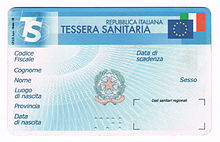Servizio Sanitario Nazionale

The Servizio Sanitario Nazionale (SSN) , German: Nationaler Gesundheitsdienst , is the name for the state health system in Italy . It guarantees the right to health care enshrined in Article 32 of the Italian Constitution .
organization
Despite the name SSN, responsibility for the health system lies largely with the Italian regions , whose regional health services together with government agencies form the SSN. The basic planning of the SSN and other coordinating tasks are carried out by the Ministry of Health in Rome .
The regional health services are usually organized in regional or local health companies (Azienda Sanitaria) such as the South Tyrolean medical company . Private health facilities can be accredited with the SSN and thus become part of the system. General practitioners receive a flat rate per capita, dental services must be borne by the citizens themselves.
The regional nature of the SSN means that the quality of the services varies greatly from region to region. There is a sharp north-south divide, which causes a strong “health tourism”, especially in the direction of Veneto , Lombardy and Emilia-Romagna .
Despite the regional differences, Italy's health system was in second place in the world rankings of the World Health Organization in 2000 . In 2014, the SSN ranked third on a world ranking based on data from the World Bank , IMF and WHO . Italy spends almost 10 percent of its GDP on health care, which is within the OECD average. The SSN is primarily financed by tax revenues. Added to this are the health companies' own income and co-payments from patients.
history
Until the establishment of the SSN in 1980, the Italian health system was based on private health insurances and public health insurances , of which the Istituto Nazionale per l'Assicurazione contro le Malattie (INAM) was the most important. The system was considered unbalanced and incomplete because it was based on employment relationships and the co-insurance of family members and the insurance policies covered very different benefits.
Until 1968 the hospitals were mainly run by charitable organizations. The hospitals were transformed into public corporations and included first in national and then regional health planning.
See also
- Istituto Nazionale della Previdenza Sociale
- Istituto nazionale per l'assicurazione contro gli infortuni sul lavoro
- National Health Service
- Germany's health system
- Health system in Austria
- Health care in Switzerland